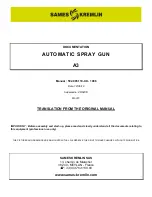
5 - Operation
33
Cleaning
General info
In order to derive full benefit from the sprayer for many years the following service and maintenance program should be
followed.
μ
ATTENTION! Always read the individual paragraphs. Read instructions for service/maintenance jobs carefully before
starting on the job. If any portion remains unclear or requires facilities which are not available, then for safety reasons
please leave the job to your HARDI dealer’s workshop.
μ
ATTENTION!
Clean sprayers are safe sprayers.
Clean sprayers are ready for action.
Clean sprayers cannot be damaged by pesticides and their solvents.
Guidelines
1.
Read the whole chemical label. Take note of any particular instructions regarding recommended protective clothing,
deactivating agents, etc. Read the detergent and deactivating agent labels. If cleaning procedures are given, follow
them closely.
2.
Be familiar with local legislation regarding disposal of pesticides washings, mandatory decontamination methods, etc.
Contact the appropriate authority if you are in doubt.
3.
Pesticide washings can usually be sprayed out on the field just sprayed or at a suitable cultivated area. Avoid emptying
the washings at the same spot every time and keep sufficient distance to the water environment. You must prevent
seepage or runoff of residue into streams, water courses, ditches, wells, springs, etc. The washings from the cleaning
area must not enter sewers. Alternatively the washings can be retained in an appropriate receptacle, diluted and
distributed over a larger cultivated area - see also Filling/washing location requirements on page 27.
4.
Cleaning starts with the calibration, as a well calibrated sprayer will ensure the minimal amount of remaining spray
liquid.
5.
It is good practice to clean the sprayer immediately after use and thereby rendering the sprayer safe and ready for the
next pesticide application. This also prolongs the life of the components. It is strongly advised to perform an internal
cleaning of the sprayer when high concentration of acids or chloride are present in the active ingredients, or if the spray
liquid is corrosive. For the best result use a cleaning agent recommended by Hardi, e.g. AllClearExtra.
6.
It is sometimes necessary to leave spray liquid in the tank for short periods, e.g. overnight, or until the weather becomes
suitable for spraying again. Unauthorized persons and animals must not have access to the sprayer under these
circumstances.
7.
If the product applied is corrosive, it is recommended to coat all metal parts of the sprayer before and after use with a
suitable rust inhibitor.
8.
The sprayer must always be parked under roof to avoid rain washing off pesticides and build-up of spot contamination
in the soil. If parked outside the sprayer should be parked on the filling/washing location in order to retain possible
pesticides.
Cleaning and maintaining the filters
Clean filters ensure:
•
Mistblower parts, such as the valves, diaphragms and operating units, are not blocked or damaged during use.
•
Nozzles are not blocked during spraying.
The pump has a long service life. A clogged suction filter will result in pump cavitation. The main filter that protects the
mistblower parts is the suction filter. Check it regularly.
Содержание ZEBRA AXIAL
Страница 1: ...ZEBRA Original Instruction book 67026102 100 version 1 00 GB 08 2015 www hardi es ...
Страница 6: ...Table of Contents 6 ...
Страница 8: ...1 EC Declaration 8 ...
Страница 20: ...3 Description 20 ...
Страница 26: ...4 Start up 26 ...
Страница 54: ...Index 54 ...
Страница 56: ...ILEMO HARDI S A U Poligono Industrial El Segre 712 713 25080 Lleida SPAIN ...
















































